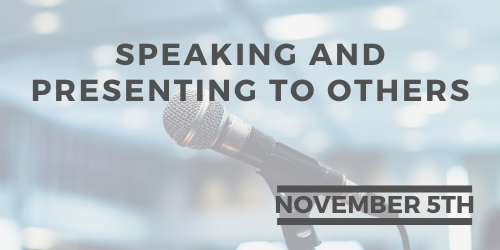Stay Calm and Speak Up
With conference season coming, we got to thinking about all the presenters who are putting the finishing touches on keynotes and breakout sessions. In solidarity and support, we wanted to pass along a few tips to help tone-down the stress that often accompanies public speaking even in a virtual setting.
Public speaking keeps popping up in surveys and studies as one of our most common fears. In fact, some rank public speaking higher on the list of fears than death! So how can we boost your confidence and make standing up and talking in front of other people less scary? We've got a few ideas...
1. Allow Yourself Plenty of Prep Time
The caveat to this one is that you'll almost never be as prepared as you want to be. No matter how much time you spend on your slides, speech, and practice, you'll always wish you had at least a few more minutes. If you're good at self discipline, start a week sooner than you think you need to. If you err on the side of pressure-prompted (ahem, lookin' at you, procrastinators), put some external deadlines in place--ask someone to review your presentation well ahead of the deadline, or ask someone close to you (spouse, roommate, sibling) to gently bug you about it and ask for progress updates. Simply having a reminder that brings it to your attention on a daily basis will help you muster up the motivation to get it done, if for no other reason than you get sick of telling that person, "Erm, I haven't started it yet."
2. Spend Time on Your Stories
.jpg?width=300&name=front-view-pile-books-with-copy-space%20(1).jpg) It's pretty easy to glance through your outline and think to yourself, "here's where I'll talk about XYZ" or "here's where I'll tell my ______ story." Spend some extra time actually telling your story--what moments will you emphasize, what can you gloss over so you don't lose audience interest? One of the worst things you can do for your listeners is to fumble through a story, lose your place, or stop storytelling and start rambling. Even if you're comfortable with your presentation outline, practice telling your stories at least twice--it will help you stay focused and calm in-the-moment when have an audience.
It's pretty easy to glance through your outline and think to yourself, "here's where I'll talk about XYZ" or "here's where I'll tell my ______ story." Spend some extra time actually telling your story--what moments will you emphasize, what can you gloss over so you don't lose audience interest? One of the worst things you can do for your listeners is to fumble through a story, lose your place, or stop storytelling and start rambling. Even if you're comfortable with your presentation outline, practice telling your stories at least twice--it will help you stay focused and calm in-the-moment when have an audience.
3. Create a Contingency Plan
A lot of our fear or anxiety is rooted in the "what if." We agonize over what could possibly go wrong, which takes time and mental energy away from valuable prep and practice work, and sneaks into our subconscious to fester and sabotage our presentation. So instead of (futilely) ignoring your biggest fears, let yourself focus on them for a few minutes. Think about your greatest fears when it comes to a specific presentation. Narrow it down to your top two or three "what ifs" and create a backup plan for each one. What if technology doesn't cooperate? What if people are missing? What if I get interrupted by someone who didn't mute themselves on the Zoom? Think about the things that would trip you up the most, and plan on how you'll compensate or overcome them instead of letting it throw you off in-the-moment.
4. Don't Forget to Breathe!
 Sometimes no matter how practiced and polished your presentation is, you still find yourself with sweaty palms, shaky hands, and a pounding heart. Before you get into full-fledged panic attack mode, take 3-5 big, deep breaths. Concentrate on expanding your ribs and diaphragm, and exhaling slowly. Don't rush yourself, and remember--you got this!
Sometimes no matter how practiced and polished your presentation is, you still find yourself with sweaty palms, shaky hands, and a pounding heart. Before you get into full-fledged panic attack mode, take 3-5 big, deep breaths. Concentrate on expanding your ribs and diaphragm, and exhaling slowly. Don't rush yourself, and remember--you got this!
Join us on November 5th for Speaking and Presenting to Others to practice overcoming any public speaking jitters in a safe space.









